Author: Alex Thorn, Gabe Parker, Galaxy; Translator: Wuzhu, Golden Finance
Foreword
2024 was a brilliant year for the cryptocurrency market, with the launch of spot Bitcoin ETP in January and the election of the most crypto-friendly president and Congress in U.S. history in November. Overall, the liquid cryptocurrency market added $1.6 trillion in market value in 2024, up 88% year-over-year to $3.4 trillion for the year. Bitcoin alone added $1 trillion in market value, approaching $2 trillion for the year. The cryptocurrency narrative in 2024 was driven by Bitcoin’s meteoric rise on the one hand (accounting for 62% of total market gains) and memes and AI on the other.For much of the year, memes were the hot cryptocurrency, and most on-chain activity occurred on Solana. Tokens operated by AI agents took center stage in the pre-Bitcoin cryptocurrency space in the second half of the year.
Crypto venture capital in 2024 remains difficult. None of these major Bitcoin, meme, AI agent coins are particularly suitable for venture capital. Memecoins can be launched with just a few clicks of a button, and Memecoins and AI agent coins exist almost entirely on-chain, leveraging existing infrastructure primitives. Hot sectors in the last market cycle, such as DeFi, gaming, the metaverse, and NFTs, have either failed to gain market attention or are already built out and require less capital, making new startups more competitive. Crypto market infrastructure and gaming are largely already built out and are now in late stages, and with expected changes to US regulation under the next administration, these sectors may face competition from entrenched traditional financial services intermediaries. There are signs that new meta-currencies could become important drivers of new capital inflows, but these range from immature to very nascent:Stand out among them are stablecoins, tokenization, the integration of DeFi with TradFi, and the overlap of crypto and AI.
Macro and broader market forces also continue to present headwinds. The high interest rate environment continues to weigh on the VC industry, with allocators less willing to take risks further down the risk curve. This phenomenon has squeezed the VC industry as a whole, but the crypto VC industry may be particularly affected given its risk profile. Meanwhile, large, integrated VC firms are still mostly avoiding the space, perhaps still feeling cautious following the bankruptcies of several high-profile VC firms in 2022.
So while there are significant opportunities ahead, either through the resurgence of existing originals and narratives or the emergence of new ones, crypto VC remains competitive and subdued compared to the frenzy of 2021 and 2022.
Deal and investment capital both increased, but the number of new funds stagnated and capital allocated to VC funds decreased, creating a particularly competitive environment that favors founders in negotiating valuations. Broadly speaking, VC investment remains well below levels seen in prior market cycles.
But the increasing institutionalization of Bitcoin and digital assets, as well as the growth of stablecoins, and the possibility that the new regulatory environment may ultimately portend some convergence between DeFi and TradFi, also present new opportunities for innovation, and we expect 2025 could see a meaningful recovery in VC activity and interest.
Summary
VC investment in cryptocurrency startups was $3.5 billion (up 46% QoQ) across 416 deals (down 13% QoQ) in Q4 2024.
Throughout 2024, venture capitalists invested $11.5 billion in startups focused on crypto and blockchain across 2,153 deals.
Early-stage deals received the most capital invested (60%), while later-stage deals accounted for 40% of invested capital, a significant increase from 15% in Q3.
The median valuation of venture capital deals increased in Q2 and Q3, with valuations of crypto-specific deals growing faster than the overall venture industry, but remained flat quarter-over-quarter in Q4.
Stablecoin companies raised the most funds, led by Tether’s $600 million from Cantor Fitzgerald, followed by infrastructure and Web3 startups. Web3, DeFi, and infrastructure companies accounted for the largest number of deals.
In Q4, most investments went to startups headquartered in the United States (46%), while Hong Kong companies accounted for 17% of all invested capital. In terms of deal count, the United States led with 36%, followed by Singapore (9%) and the United Kingdom (8%).
In terms of funding, investor interest in cryptocurrency-focused VC funds fell to $1 billion across 20 new funds.
In 2024, at least 10 cryptocurrency VC funds raised more than $100 million.
Venture Capital
Number of Deals and Invested Capital
In Q4 2024, venture capitalists invested $3.5 billion (up 46% QoQ) in 416 deals (down 13% QoQ) into cryptocurrency and blockchain-focused startups.
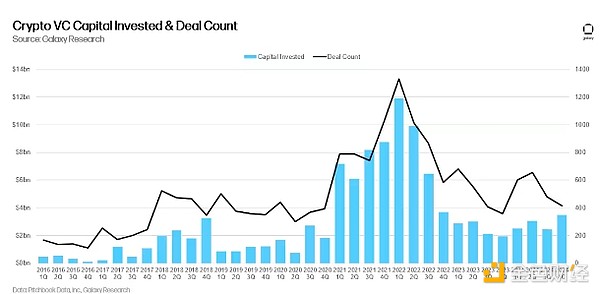
As of 2024, venture capitalists have invested a total of $11.5 billion in cryptocurrency and blockchain startups through 2,153 deals.
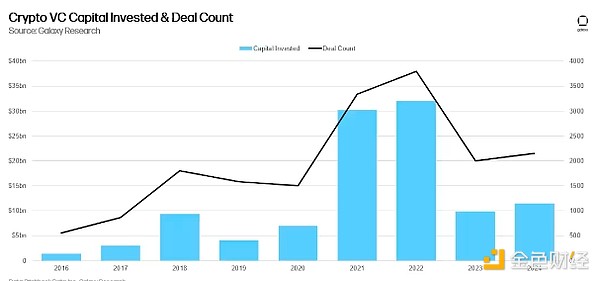
Investment Capital and Bitcoin Price
In previous cycles, there was a multi-year correlation between Bitcoin prices and capital invested in crypto startups, but this correlation has struggled to recover over the last year. Since January 2023, Bitcoin has risen sharply while venture capital activity has struggled to keep pace. Weaker allocator interest in crypto venture and broad venture capital, combined with a crypto market narrative that favors Bitcoin and ignores many of the hot narratives in 2021, can partially explain this difference.
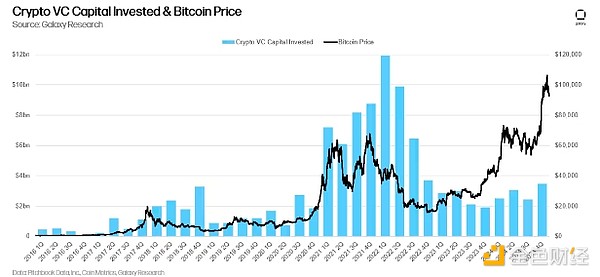
Investment by stage
In the fourth quarter of 2024, 60% of venture capital was invested in early-stage companies, while 40% was invested in late-stage companies.Venture capital firms raised new funds in 2024, while crypto-native funds may still be able to obtain funds from large-scale financings a few years ago. Starting in the third quarter, more and more capital has flowed to late-stage companies, which can partly explain Tether's $600 million raised from Cantor Fitzgerald.
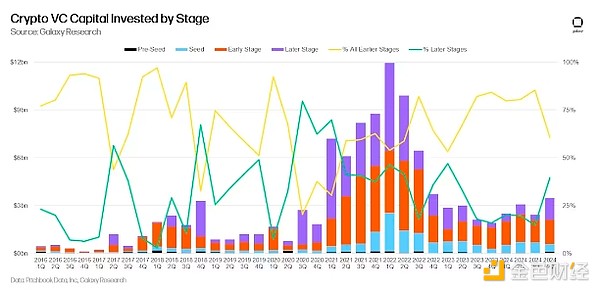
In terms of deals, the proportion of pre-seed deals has increased slightly and remains healthy compared to previous cycles. We track the proportion of pre-seed deals as a measure of the robustness of entrepreneurial behavior.
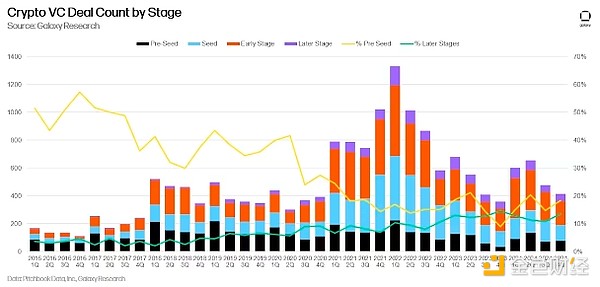
Valuations and Deal Size
Valuations of venture-backed cryptocurrency companies fell sharply in 2023, reaching their lowest level since Q4 2020 in Q4 2023. However, valuations and deal size began to rebound in Q2 2024 as Bitcoin hit a record high. Valuations reached their highest levels since 2022 in Q2 and Q3 2024. The growth in cryptocurrency deal size and valuations in 2024 is consistent with similar growth in the venture capital sector as a whole, although the rebound in cryptocurrencies has been stronger. The median pre-money valuation of deals in Q4 2024 was $24 million, with an average deal size of $4.5 million.
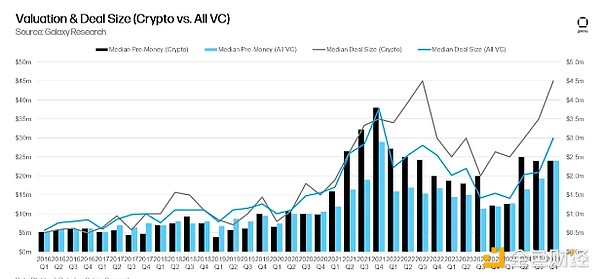
Investment Categories
Companies and projects in the “Web3/NFT/DAO/Metaverse/Gaming” category accounted for the largest share (20.75%) of crypto venture capital raised in Q4 2024, totaling $771.3 million. The three largest deals in the category were Praxis, Azra Games, and Lens, which raised $525 million, $42.7 million, and $31 million, respectively. DeFi’s dominance as a percentage of total crypto VC funding is attributed to Tether’s $600 million deal with Cantor Fitzgerald, which took a 5% stake in the firm (stablecoin issuers fall into our premium DeFi category). While this deal was not a traditional VC structured deal, we included it in our dataset. If we removed Tether’s deal, the DeFi category would have ranked 7th in terms of investment dollars in Q4.
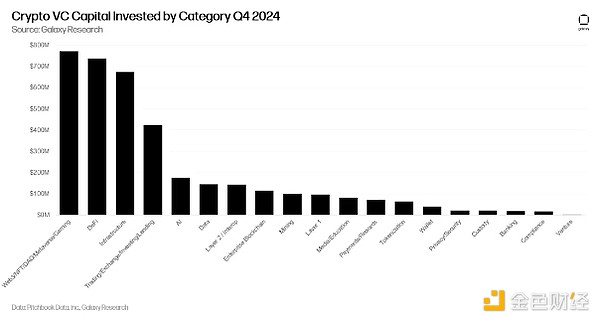
In the fourth quarter of 2024, crypto startups building Web3/NFT/DAO/Metaverse and infrastructure products accounted for 44.3% and 33.5% of the total quarterly crypto venture capital investment, respectively. The increase in capital allocation as a percentage of total capital deployment is mainly attributed to the significant quarter-on-quarter decline in capital allocation of crypto venture capital to Layer 1 and crypto AI startups, which have fallen by 85% and 55%, respectively, since the third quarter of 2024.
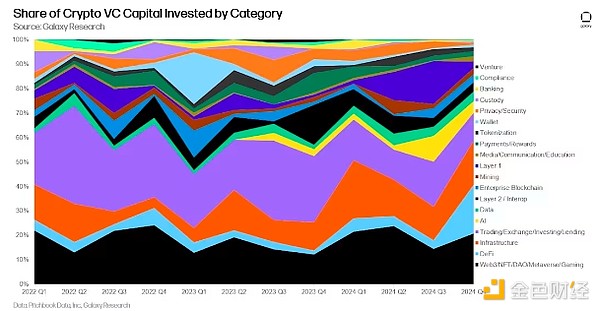
If we break down the broad categories in the above chart into more granular pieces, crypto projects building stablecoins raised the largest share of crypto venture capital in Q4 2024 (17.5%), totaling $649 million across 9 tracked deals. However, Tether’s $600 million deal represented the majority of total capital invested in stablecoin companies in Q4 2024. Crypto startups developing infrastructure raised the second-most venture capital in Q4 2024 at $592 million (16%) across 53 tracked deals. The top three crypto infrastructure deals were Blockstream, Hengfeng Group, and Cassava Network, raising $210 million, $100 million, and $90 million, respectively. After crypto infrastructure, Web3 startups and exchanges ranked third and fourth in terms of funding raised from crypto VCs, totaling $587.6 million and $200 million, respectively. Notably, Praxis was the largest and second largest Web3 deal in Q4 2024, raising a whopping $525 million to build an “internet-native city.”
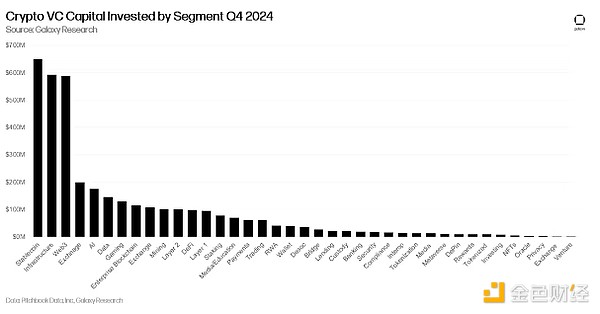
In terms of transaction number, Web3/NFT/DAO/Metaverse/Games accounted for 22% of transactions (92 transactions), of which 37 game transactions and 31 Web3 transactions were driving factors. The largest game transaction in the fourth quarter of 2024 was Azra Games, which raised $42.7 million in its Series A funding. Closely following are infrastructure and trading/exchange/investment/lending, with 77 and 43 transactions respectively in the fourth quarter of 2024.
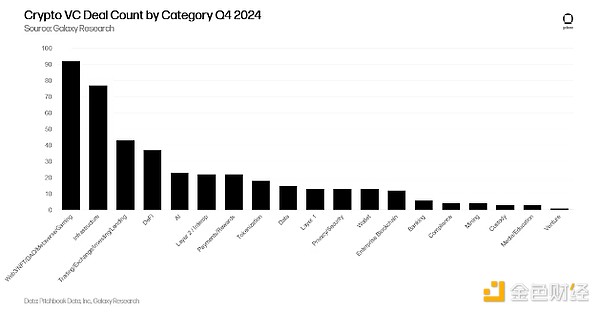
Projects and companies providing crypto infrastructure ranked second in terms of transaction volume, accounting for 18.3% of the total transaction volume (77 transactions), an increase of 11 percentage points month-on-month. Following crypto infrastructure, projects and companies building trading/exchange/investment/lending products ranked third in terms of transaction volume, accounting for 10.2% of the total transaction volume (43 transactions). Notably, crypto companies building wallets and payment/rewards products saw the largest month-over-month increases in deal volume, at 111% and 78%, respectively. While these month-over-month increases are large in percentage terms, wallet and payment/rewards startups only accounted for 22 and 13 deals, respectively, in Q4 2024.
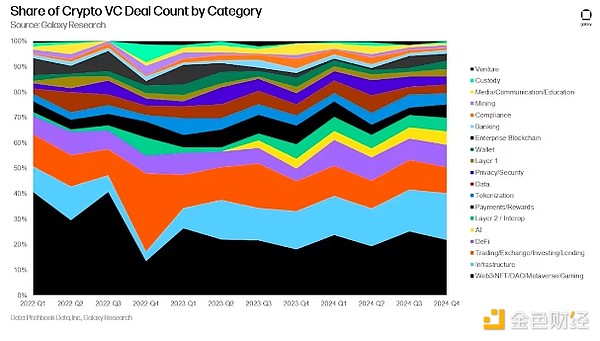
Breaking down the broad categories in the above chart into more granular pieces, projects and companies building crypto infrastructure saw the most deals (53) across all sectors. They were followed by gaming and Web3-related crypto companies, which completed 37 and 31 deals, respectively, in Q4 2024, almost in the same order as in Q3 2024.
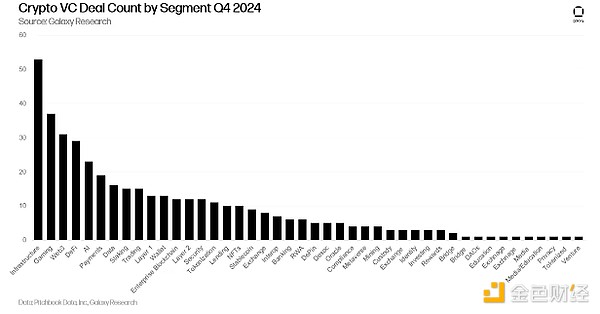
Investments by Stage and Category
Breaking down investment capital and deal count by category and stage provides a clearer picture of what types of companies in each category are raising funding. In Q4 2024, the vast majority of capital in Web3/DAO/NFT/Metaverse, Layer 2s, and Layer 1s went to early-stage companies and projects. In contrast, a large portion of crypto VC funds invested in DeFi, Trading/Exchanges/Investing/Lending, and Mining went to later-stage companies. This is to be expected given the relative maturity of the latter relative to the former.
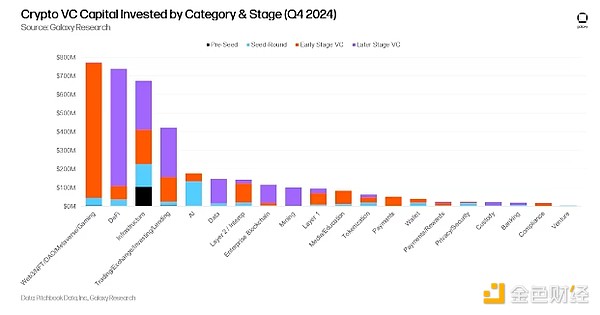
Analyzing the distribution of investment capital at different stages in each category can reveal the relative maturity of various investment opportunities.
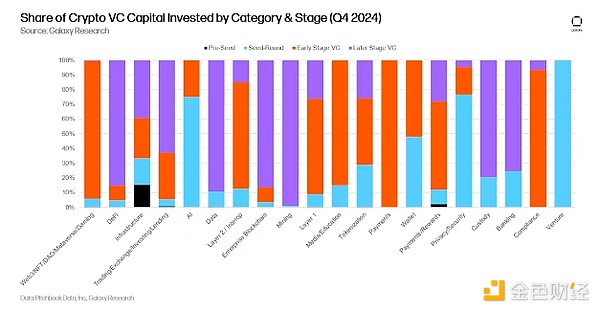
Like the crypto venture capital invested in Q3 2024, a large portion of the deals completed in Q4 2024 involved early-stage companies. The crypto venture capital deals tracked in Q4 2024 included 171 early-stage deals and 58 late-stage deals.
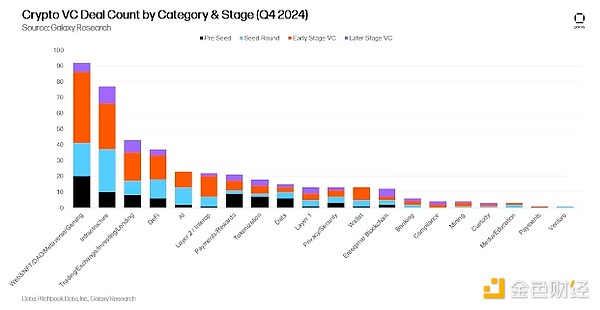
Examining the share of deals completed by stage within each category provides insight into the various stages of each investable category.
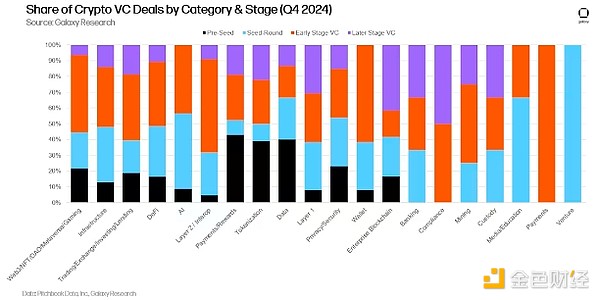
Investment by Geography
In the fourth quarter of 2024, 36.7% of the deals involved companies headquartered in the United States. It was followed by Singapore (9%), the United Kingdom (8.1%), Switzerland (5.5%) and the United Arab Emirates (3.6%).
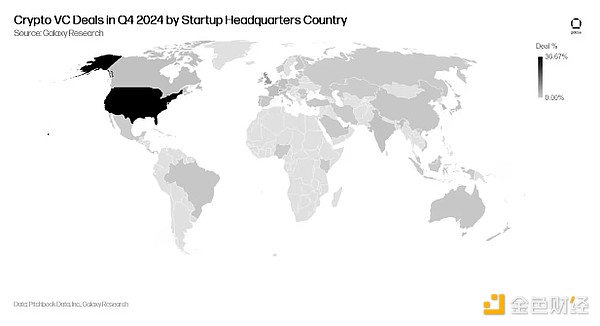
US-based companies absorbed 46.2% of all venture capital, down 17 percentage points from the previous month. As a result, venture capital capital allocation to startups headquartered in Hong Kong increased significantly, reaching 17.4%. The UK was 6.8%, Canada was 6%, and Singapore was 5.4%.
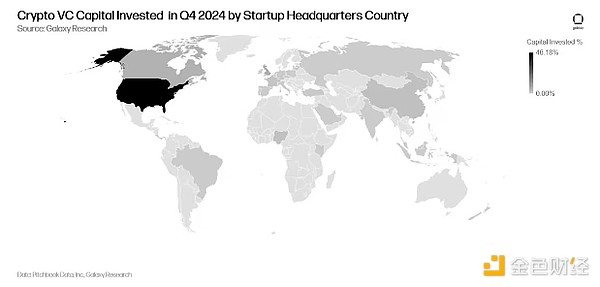
Group Investment
Companies and projects established in 2019 accounted for the largest share of capital, while those established in 2024 had the largest number of transactions.
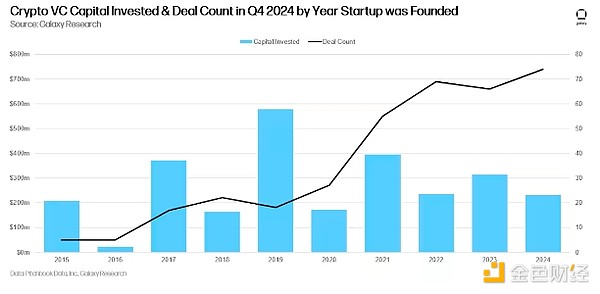
Venture Capital Financing
Financing for crypto venture funds remains challenging. The macro environment and crypto market volatility in 2022 and 2023 made some allocators reluctant to make the same level of commitment to crypto venture investors as they did in 2021 and early 2022. At the beginning of 2024, investors generally believed that interest rates would fall significantly in 2024, although the rate cuts did not begin to materialize until the second half of the year. Since the third quarter of 2023, total capital allocated to venture funds has continued to decline month-on-month, despite an increase in the number of new funds throughout 2024.

On an annualized basis, 2024 was the weakest year for crypto venture capital fundraising since 2020, with a total of 79 new funds raising $5.1 billion, far below the frenzy of 2021-2022.
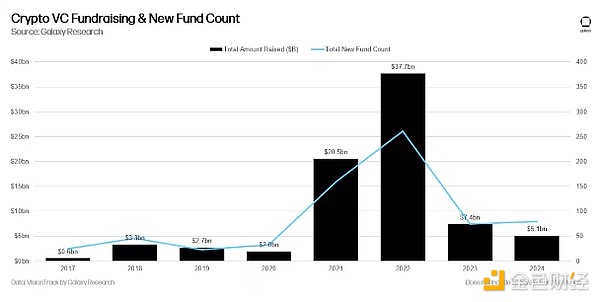
While the number of new funds did increase slightly year-on-year, the decline in allocator interest also led to smaller funds raised by venture capital firms, with the median and average fund sizes in 2024 reaching their lowest levels since 2017.
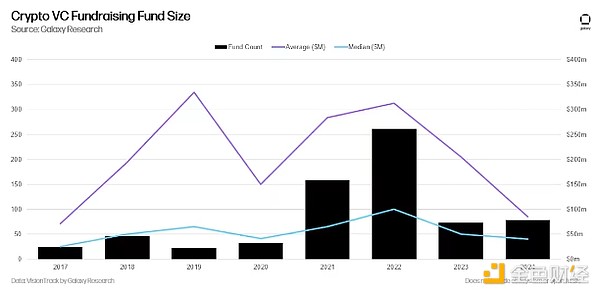
At least 10 cryptocurrency venture funds that actively invest in cryptocurrencies and blockchain startups have raised more than $100 million for new funds in 2024.
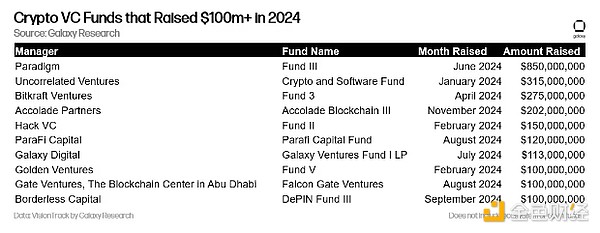
Summary
Sentiment is improving and activity is increasing, although both are still well below previous highs. While the liquid crypto asset market has recovered significantly from the end of 2022 and the beginning of 2023, venture investment activity is still far below the previous bull market. The bull runs of 2017 and 2021 were marked by a high correlation between venture activity and liquid crypto asset prices, but over the past two years, activity has been sluggish while crypto has rebounded. The stagnant venture capital investment is due to a combination of factors, including a “barbell market” that put Bitcoin (and its new ETF) center stage, and marginal net new activity from meme coins, which have been difficult to fund and have questionable longevity. Enthusiasm for projects at the intersection of AI and crypto is growing, and expected regulatory changes could open the door to opportunities in stablecoins, DeFi, and tokenization.
Early Stage Deals Continue to Lead the Way. Despite the headwinds facing venture capital, interest in early stage deals still bodes well for the long-term health of the broader crypto ecosystem. The late stage deal cohort made progress in the fourth quarter, but mainly due to Cantor Fitzgerald’s $600 million investment in Tether. Still, entrepreneurs continue to find willing investors for new and innovative ideas. We believe projects and companies building stablecoins, AI, DeFi, tokenization, L2, and Bitcoin-related products will do well in 2025. Spot ETPs could put pressure on funds and startups. Several high-profile investments in spot Bitcoin ETPs by U.S. allocators suggest that some large investors (pensions, endowments, hedge funds, etc.) may be gaining exposure to the industry through large liquid vehicles rather than turning to early-stage venture investments. Interest in spot Ethereum ETPs has already begun to increase, and if this continues, or even if new ETPs are launched covering other alternative layer 1 blockchains, demand for niches such as DeFi or Web3 may flow to ETPs rather than the VC complex.
Fund managers still face a difficult environment. While the number of new funds in 2024 increases slightly year-over-year, total capital allocated to crypto VC funds is slightly lower than in 2023. Macroeconomics continues to create headwinds for allocators, but significant changes in the regulatory environment could reignite allocators' interest in the space.
The United States continues to dominate the crypto startup ecosystem. Despite a very tricky and often hostile regulatory regime, US-based companies and projects still account for the majority of completed deals and the majority of invested capital. The new presidential administration and Congress will be the most pro-cryptocurrency in history, and We expect US dominance to increase, especially if certain regulatory matters solidify as expected, such as stablecoin frameworks and market structure legislation, which would allow traditional US financial services companies to seriously consider entering the space.
 Aaron
Aaron
 Aaron
Aaron Jasper
Jasper Catherine
Catherine Clement
Clement Snake
Snake Alex
Alex Kikyo
Kikyo Davin
Davin Jasper
Jasper Hui Xin
Hui Xin